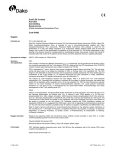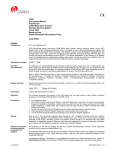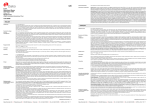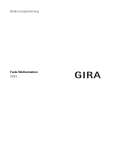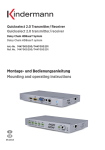Download FLEX Polyclonal Rabbit Anti-Human CD3 Ready-to
Transcript
desire a different staining intensity, a Dako Application Specialist/Technical Service Specialist can be contacted for information on re-programming of the protocol. Verify that the performance of the adjusted protocol is still valid by evaluating that the staining pattern is identical to the staining pattern described in “Performance characteristics”. Counterstaining in hematoxylin is recommended using EnVision FLEX Hematoxylin, (Dako Autostainer/Autostainer Plus) (Code K8018). Non-aqueous, permanent mounting medium is recommended. Positive and negative controls should be run simultaneously using the same protocol as the patient specimens. The positive control tissue should include tonsil and the cells/structures should display reaction patterns as described for this tissue in “Performance characteristics” in all positive specimens. The recommended negative control reagent is FLEX Negative Control, Rabbit, (Dako Autostainer/Autostainer Plus) (Code IS600). FLEX Polyclonal Rabbit Anti-Human CD3 Ready-to-Use (Dako Autostainer/Autostainer Plus) Staining interpretation Cells labeled by the antibody display cytoplasmic and/or membrane staining. Code IS503 ENGLISH Intended use For in vitro diagnostic use. FLEX Polyclonal Rabbit Anti-Human CD3, Ready-to-Use, (Dako Autostainer/Autostainer Plus), is intended for use in immunohistochemistry together with Dako Autostainer/Autostainer Plus instruments. This antibody is useful for the identification of T cells and related neoplasms (1, 2). The clinical interpretation of any staining or its absence should be complemented by morphological studies using proper controls and should be evaluated within the context of the patient's clinical history and other diagnostic tests by a qualified pathologist. Synonym for antigen T3, CD3 complex (3). Summary and explanation CD3 consists of at least four different components (γ,δ,ε,ζ) of 20-28 kDa. On the lymphocyte cell surface, CD3 is non-covalently associated with the T-cell receptor (TCR). It is believed that the CD3 components of the TCR/CD3 complex mediate signal transduction upon antigen recognition by TCR (4). CD3 is expressed by T cells in thymus, bone marrow, peripheral lymphoid tissue and blood (5, 6). The only other normal cell type known to be labeled by antibodies to CD3, is Purkinje cells in the cerebellum (7). The CD3 antigen is first detectable in early thymocytes and its appearance probably represents one of the earliest signs of commitment to the T-cell lineage (5). In immature thymocytes the CD3 expression is solely cytoplasmic, membrane-associated CD3 appears subsequently upon cell maturation (5). The majority of T-cell neoplasms express the CD3 antigen, while it is absent from non T-cell lymphoid malignancies (8). Consistent with the pattern of synthesis of the antigen in normal thymocytes, the earliest site where CD3 is detectable within neoplastic cells is in the cell cytoplasm (5). CD3 has been deemed an essential marker for the initial evaluation of chronic lymphoproliferative disorders (9). Large granular lymphocyte leukaemia of T-cell type (T-LGL) is characterized by the CD3+/CD57+/CD56immunophenotype and clonal rearrangement of the T-cell receptor genes (10). Refer to Dako’s General Instructions for Immunohistochemical Staining or the detection system instructions of IHC procedures for: 1) Principle of Procedure, 2) Materials Required, Not Supplied, 3) Storage, 4) Specimen Preparation, 5) Staining Procedure, 6) Quality Control, 7) Troubleshooting, 8) Interpretation of Staining, 9) General Limitations. Reagent provided Ready-to-use polyclonal rabbit antibody provided in liquid form in a buffer containing stabilizing protein and 0.015 mol/L sodium azide. Immunogen Synthetic peptide comprising amino acids 156-168 from the cytoplasmic part of the human CD3ε−chain coupled to thyroglobulin (1). Specificity In Western blotting, the antibody detects bands of the expected molecular weights for CD3 antigens (2). The antibody recognizes CD3ε in both a T-cell line (Jurkat) and a natural killer cell line (NK11), but does not react with lysates prepared from several B cell lines (Raji, Ramos and JY), a myeloid cell line (U937) or a colon carcinoma cell line (Colo-205) (11). In immunoprecipitation from Nonidet P40 lysates of surface-iodated T lymphoblasts, the antibody precipitates the γ (26 kDa), δ (21 kDa) and ε (19 kDa) chain of the CD3 molecule, similar to the precipitation pattern seen using the well-characterized monoclonal mouse anti-human CD3, clone UCHT1 (1). In ELISA, the antibody labels the CD3 peptide used as immunogen. Precautions 1. For professional users. 2. This product contains sodium azide (NaN3), a chemical highly toxic in pure form. At product concentrations, though not classified as hazardous, sodium azide may react with lead and copper plumbing to form highly explosive build-ups of metal azides. Upon disposal, flush with large volumes of water to prevent metal azide build-up in plumbing. 3. As with any product derived from biological sources, proper handling procedures should be used. 4. Wear appropriate Personal Protective Equipment to avoid contact with eyes and skin. 5. Unused solution should be disposed of according to local, State and Federal regulations. Storage Store at 2-8 °C. Do not use after expiration date sta mped on vial. If reagents are stored under any conditions other than those specified, the conditions must be verified by the user. There are no obvious signs to indicate instability of this product. Therefore, positive and negative controls should be run simultaneously with patient specimens. If unexpected staining is observed which cannot be explained by variations in laboratory procedures and a problem with the antibody is suspected, contact Dako Technical Support. Specimen preparation including materials required but not supplied The antibody can be used for labeling formalin-fixed, paraffin-embedded tissue sections. Tissue specimens should be cut into sections of approximately 4 µm. Pre-treatment with heat-induced epitope retrieval (HIER) is required using Dako PT Link (Code PT100/PT101). For details, please refer to the PT Link User Guide. Optimal results are obtained by pretreating tissues using EnVision FLEX Target Retrieval Solution, High pH (50x) (Code K8010/K8004). Paraffin-embedded sections: Pre-treatment of formalin-fixed, paraffin-embedded tissue sections is recommended using the 3-in-1 specimen preparation procedure for Dako PT Link. Follow the pre-treatment procedure outlined in the package insert for EnVision FLEX Target Retrieval Solution, High pH (50x) (Code K8010/K8004). Note: After staining the sections must be dehydrated, cleared and mounted using permanent mounting medium. Deparaffinized sections: Pre-treatment of deparaffinized formalin-fixed, paraffin-embedded tissue sections is recommended using Dako PT Link and following the same procedure as described for paraffin-embedded sections. After staining the slides should be mounted using aqueous or permanent mounting medium. The tissue sections should not dry out during the treatment or during the following immunohistochemical staining procedure. For greater adherence of tissue sections to glass slides, the use of FLEX IHC Microscope Slides (Code K8020) is recommended. Staining procedure including materials required but not supplied The recommended visualization system is EnVision FLEX, High pH, (Dako Autostainer/Autostainer Plus) (Code K8010). The staining steps and incubation times are preprogrammed into the software of Dako Autostainer/Autostainer Plus instruments, using the following protocols: Template protocol: FLEXRTU2 (200 µL dispense volume) or FLEXRTU3 (300 µL dispense volume) Autoprogram: CD3 (without counterstaining) or CD3H (with counterstaining) The Auxiliary step should be set to “rinse buffer” in staining runs with ≤10 slides. For staining runs with >10 slides the Auxiliary step should be set to “none”. This ascertains comparable wash times. All incubation steps should be performed at room temperature. For details, please refer to the Operator’s Manual for the dedicated instrument. If the protocols are not available on the used Dako Autostainer instrument, please contact Dako Technical Services. Optimal conditions may vary depending on specimen and preparation methods, and should be determined by each individual laboratory. If the evaluating pathologist should (115285-002) Dako Denmark A/S IS503/EFG/MNI/2009.12.04 p. 1/4 | Produktionsvej 42 | DK-2600 Glostrup | Denmark | Tel. +45 44 85 95 00 | Fax +45 44 85 95 95 | CVR No. 33 21 13 17 Performance characteristics Normal tissues: The antibody labels T cells in various tissues including tonsil and colon. T cells in the interfollicular areas of tonsil show a moderate to strong staining reaction, whereas T cells in germinal centers of tonsil and in the colon epithelium show a weak to moderate staining reaction. Abnormal tissues: The antibody labeled 73/96 T-cell neoplasms, including 7/9 lymphoblastic, 25/35 pleomorphic, 5/5 immunoblastic, 5/5 angioimmunoblastic lymphadenopathy-like, 2/2 T zone lymphomas, 19/19 mycosis fungoides/Sézary syndrome, 2/3 Lennert’s lymphomas, 4/13 Ki-1 positive anaplastic large cell lymphomas, 3/4 lymphomatoid papulosis, 1/1 coeliac-associated lymphoma (1). The antibody labeled 149/149 cases of T-cell (precursor) acute lymphoblastic leukaemias/lymphomas (ALL). In 131/149 cases, 100% of the cells were positive; in 14 cases between 50-90% of the cells were positive; and in 4 cases less than 50% of the cells were positive. No labeling was observed in 68/68 cases of B-cell (precursor) ALL, apart from reactive infiltrating T cells (2). FRANÇAIS Utilisation prévue Pour utilisation diagnostique in vitro. FLEX Polyclonal Rabbit Anti-Human CD3, Ready-to-Use, (Dako Autostainer/Autostainer Plus) est destiné à une utilisation en immunohistochimie avec les instruments Dako Autostainer/Autostainer Plus. Cet anticorps est utile pour l’identification des lymphocytes T et des néoplasmes liés (1, 2). L’interprétation clinique de toute coloration ou son absence doit être complétée par des études morphologiques en utilisant des contrôles appropriés et doit être évaluée en fonction des antécédents cliniques du patient et d’autres tests diagnostiques par un pathologiste qualifié. Synonymes de l’antigène T3, complexe CD3 (3). Résumé et explication La CD3 comporte au moins quatre composants différents (g,d,e,z) de 20 à 28 kDa. À la surface des lymphocytes, la CD3 est liée de manière non covalente au récepteur des lymphocytes T (TCR). On pense que les composants de la CD3 du complexe TCR/CD3 interviennent dans la transduction du signal lors de la reconnaissance de l’antigène par le TCR (4). La CD3 est exprimée par les lymphocytes T dans le thymus, la moelle osseuse, le tissu lymphoïde périphérique et le sang (5, 6). Le seul autre type de cellule normal connu pour être marqué par les anticorps anti-CD3 est les cellules de Purkinje du cervelet (7). L’antigène anti-CD3 est d’abord détectable dans les thymocytes précoces et sa présence constitue probablement l’un des premiers signes d’appartenance à la lignée des lymphocytes T (5). Dans les thymocytes immatures, l’expression de la CD3 est uniquement cytoplasmique et la CD3 associée à la membrane apparaît par la suite, après la maturation cellulaire (5). La majorité des néoplasmes à lymphocytes T exprime l’antigène anti-CD3, alors qu’il est absent des tumeurs lymphoïdes non à lymphocytes T (8). Conformément au schéma de synthèse de l’antigène des thymocytes normaux, le premier site où la CD3 est détectable au sein des cellules néoplasiques est le cytoplasme cellulaire (5). La CD3 s’est révélée être un marqueur essentiel de l’évaluation initiale des troubles lymphoprolifératifs chroniques (9). La leucémie à grands lymphocytes T granuleux (T-LGL) se caractérise par l’immunophénotype CD3+/CD57+/CD56- et la réorganisation clonale des gènes des récepteurs de lymphocytes T (10). Se référer aux Instructions générales de coloration immunohistochimique de Dako ou aux instructions du système de détection relatives aux procédures IHC pour plus d’informations concernant les points suivants : 1) Principe de procédure, 2) Matériels requis mais non fournis, 3) Conservation, 4) Préparation des échantillons, 5) Procédure de coloration, 6) Contrôle qualité, 7) Dépannage, 8) Interprétation de la coloration, 9) Limites générales. Réactifs fournis Anticorps polyclonal de lapin prêt à l’emploi fourni sous forme liquide dans un tampon contenant une protéine stabilisante et 0,015 mol/L d’azide de sodium. Immunogène Peptide de synthèse comprenant les acides aminés 156–168 provenant de la partie cytoplasmique de la chaîne CD3e humaine couplée à la thyroglobuline (1). Spécificité Lors des analyses par Western blot, l’anticorps détecte des bandes de poids moléculaire attendu pour les antigènes anti-CD3 (2). L’anticorps reconnaît la CD3 tant dans une lignée de lymphocytes T (Jurkat) que dans une lignée de cellules tueuses naturelles (NK11) mais ne réagit pas aux lysats préparés à partir de plusieurs lignées de lymphocytes B (Raji, Ramos et JY), d’une lignée de cellules myéloïdes (U937) ou d'une lignée de cellules de carcinome du côlon (Colo-205) (11). Lors de l’immunoprécipitation à partir de lysats Nonidet P40 de lymphoblastes T à surface iodée, l’anticorps précipite les chaînes g (26 kDa), d (21 kDa) et e (19 kDa) de la molécule CD3, de manière similaire au schéma de précipitation observé lors de l’utilisation d’un anticorps monoclonal de souris dirigé contre la CD3 humaine bien caractérisé, clone UCHT1 (1). Lors d’un test ELISA, l’anticorps marque le peptide CD3 utilisé comme immunogène. Précautions 1. Pour utilisateurs professionnels. 2. Ce produit contient de l’azide de sodium (NaN3), produit chimique hautement toxique dans sa forme pure. Aux concentrations du produit, bien que non classé comme dangereux, l’azide de sodium peut réagir avec le cuivre et le plomb des canalisations et former des accumulations d’azides métalliques hautement explosifs. Lors de l’élimination, rincer abondamment à l’eau pour éviter toute accumulation d’azide métallique dans les canalisations. 3. Comme avec tout produit d’origine biologique, des procédures de manipulation appropriées doivent être respectées. 4. Porter un vêtement de protection approprié pour éviter le contact avec les yeux et la peau. 5. Les solutions non utilisées doivent être éliminées conformément aux réglementations locales et nationales. Conservation Conserver entre 2 et 8 °C. Ne pas utiliser après la date de péremption indiquée sur le flacon. Si les réactifs sont conservés dans des conditions autres que celles indiquées, celles-ci doivent être validées par l’utilisateur. Il n’y a aucun signe évident indiquant l’instabilité de ce produit. Par conséquent, des contrôles positifs et négatifs doivent être testés en même temps que les échantillons de patient. Si une coloration inattendue est observée, qui ne peut être expliquée par un changement des procédures du laboratoire, et en cas de suspicion d’un problème lié à l’anticorps, contacter l’assistance technique de Dako. Préparation des échantillons y compris le matériel requis mais non fourni L’anticorps peut être utilisé pour le marquage des coupes de tissus inclus en paraffine et fixés au formol. L’épaisseur des coupes d’échantillons de tissu doit être d’environ 4 µm. Un prétraitement avec démasquage d’épitope induit par la chaleur (HIER) est nécessaire avec le Dako PT Link (Réf. PT100/PT101). Pour plus de détails, se référer au Guide d’utilisation du PT Link. Des résultats optimaux sont obtenus en prétraitant les tissus à l’aide de la EnVision FLEX Target Retrieval Solution, High pH (50x) (Réf. K8010/K8004). Coupes incluses en paraffine : le prétraitement des coupes tissulaires fixées au formol et incluses en paraffine est recommandé à l'aide de la procédure de préparation d'échantillon 3-en-un pour le Dako PT Link. Suivre la procédure de prétraitement indiquée dans la notice de la EnVision FLEX Target Retrieval Solution, High pH (50x) (Réf. K8010/K8004). Remarque : après coloration, les coupes doivent être déshydratées, lavées et montées à l’aide d’un milieu de montage permanent. Coupes déparaffinées : le prétraitement des coupes tissulaires déparaffinées, fixées au formol et incluses en paraffine, est recommandé à l’aide du Dako PT Link, en suivant la même procédure que pour les coupes incluses en paraffine. Après coloration, un montage aqueux ou permanent des lames est recommandé. Les coupes de tissus ne doivent pas sécher lors du traitement ni lors de la procédure de coloration immunohistochimique suivante. Pour une meilleure adhérence des coupes de tissus sur les lames de verre, il est recommandé d’utiliser des lames FLEX IHC Microscope Slides (Réf. K8020). (115285-002) Dako Denmark A/S IS503/EFG/MNI/2009.12.04 p. 2/4 | Produktionsvej 42 | DK-2600 Glostrup | Denmark | Tel. +45 44 85 95 00 | Fax +45 44 85 95 95 | CVR No. 33 21 13 17 Procédure de coloration y compris le matériel requis mais non fourni Le système de visualisation recommandé est le EnVision FLEX, High pH, (Dako Autostainer/Autostainer Plus) (Réf. K8010). Les étapes de coloration et d’incubation sont préprogrammées dans le logiciel des instruments Dako Autostainer/Autostainer Plus, à l’aide des protocoles suivants : Protocole modèle : FLEXRTU2 (volume de distribution de 200 µL) ou FLEXRTU3 (volume de distribution de 300 µL) Autoprogram : CD3 (sans contre-coloration) ou CD3H (avec contre-coloration) L’étape Auxiliary doit être réglée sur « rinse buffer » lors des cycles de coloration avec ≤10 lames. Pour les cycles de coloration de >10 lames, l’étape Auxiliary doit être réglée sur « none ». Cela garantit des temps de lavage comparables. Toutes les étapes d’incubation doivent être effectuées à température ambiante. Pour plus de détails, se référer au Manuel de l’opérateur spécifique à l'instrument. Si les protocoles ne sont pas disponibles sur l’instrument Dako Autostainer utilisé, contacter le service technique de Dako. Les conditions optimales peuvent varier en fonction du prélèvement et des méthodes de préparation, et doivent être déterminées par chaque laboratoire individuellement. Si le pathologiste qui réalise l’évaluation désire une intensité de coloration différente, un spécialiste d’application/spécialiste du service technique de Dako peut être contacté pour obtenir des informations sur la re-programmation du protocole. Vérifier que l'exécution du protocole modifié est toujours valide en vérifiant que le schéma de coloration est identique au schéma de coloration décrit dans les « Caractéristiques de performance ». Il est recommandé d’effectuer une contre-coloration à l’aide de EnVision FLEX Hematoxylin, (Dako Autostainer/Autostainer Plus) (Réf. K8018). L’utilisation d’un milieu de montage permanent non aqueux est recommandée. Des contrôles positifs et négatifs doivent être réalisés en même temps et avec le même protocole que les échantillons du patient. Le contrôle de tissu positif doit comprendre l’amygdale et les cellules/structures doivent présenter des schémas de réaction tels que décrits pour ces tissus dans les « Caractéristiques de performance » pour tous les échantillons positifs. Le contrôle négatif recommandé est le FLEX Negative Control, Rabbit, (Dako Autostainer/Autostainer Plus) (Réf. IS600). Interprétation de la coloration Les cellules marquées par l’anticorps présentent une coloration cytoplasmique et/ou membranaire. Caractéristiques de performance Tissus sains : L’anticorps marque les lymphocytes T dans divers tissus, y compris l’amygdale et le côlon. Les lymphocytes T des zones interfolliculaires des amygdales présentent une coloration modérée à forte, tandis que la coloration des lymphocytes T des centres germinatifs de l’épithélium du côlon est faible à modérée. Tissus tumoraux : L’anticorps marque 73/96 néoplasmes à lymphocytes T, y compris 7/9 lymphoblastiques, 25/35 pléomorphes, 5/5 immunoblastiques, 5/5 angioimmunoblastiques de type lymphadénopathie, 2/2 lymphomes de la zone T, 19/19 cas de mycose fongoïde/syndrome de Sézary, 2/3 lymphomes de Lennert, 4/13 lymphomes à grandes cellules anaplasiques positifs à la Ki-1, 3/4 papuloses lymphomatoïdes, 1/1 lymphome associé à une maladie coeliaque (1). L’anticorps a marqué 149 cas sur 149 de lymphomes/leucémies lymphoblastiques aiguës à lymphocytes T (précurseurs) (LAL). Dans 131 cas sur 149, 100 % des cellules étaient positives ; dans 14 cas entre 50 et 90 % des cellules étaient positives ; et dans 4 cas, moins de 50 % des cellules étaient positives. Aucun marquage n’a été observé dans 68 cas sur 68 de LAL B (précurseurs), hormis celui des lymphocytes T infiltrants réactifs (2). DEUTSCH Vorbereitung der Probe und erforderliche, aber nicht mitgelieferte Materialien Der Antikörper eignet sich zur Markierung von formalinfixierten und paraffineingebetteten Gewebeschnitten. Gewebeproben sollten in Schnitte von ca. 4 µm Stärke geschnitten werden. Die Vorbehandlung durch hitzeinduzierte Epitopdemaskierung (HIER) mit Dako PT Link (Code-Nr. PT100/PT101) ist erforderlich. Weitere Informationen hierzu siehe PT LinkBenutzerhandbuch. Optimale Ergebnisse können durch Vorbehandlung der Gewebe mit EnVision FLEX Target Retrieval Solution, High pH (50x) (Code-Nr. K8010/K8004) erzielt werden. Paraffineingebettete Schnitte: Die Vorbehandlung der formalinfixierten, paraffineingebetteten Schnitte mit dem 3-in-1-Probenvorbereitungsverfahren für Dako PT Link wird empfohlen. Vorbehandlung gemäß der Beschreibung in der Packungsbeilage für EnVision FLEX Target Retrieval Solution, High pH (50x) (Code-Nr. K8010/K8004) durchführen. Hinweis: Nach dem Färben müssen die Schnitte dehydriert, geklärt und mit permanentem Einbettmedium auf den Objektträger aufgebracht werden. Entparaffinierte Schnitte: Eine Vorbehandlung der entparaffinierten, formalinfixierten, paraffineingebetteten Gewebeschnitte mit Dako PT Link nach demselben Verfahren, wie für die paraffineingebetteten Schnitte beschrieben, wird empfohlen. Die Objektträger nach dem Färben mit einem wässrigen oder permanenten Einbettmedium bedecken. Die Gewebeschnitte dürfen während der Behandlung oder des anschließenden immunhistochemischen Färbeverfahrens nicht austrocknen. Zur besseren Haftung der Gewebeschnitte an den Glasobjektträgern wird die Verwendung von FLEX IHC Microscope Slides (Code-Nr. K8020) empfohlen. Färbeverfahren und erforderliche, aber nicht mitgelieferte Materialien Das empfohlene Visualisierungssystem ist EnVision™ FLEX, High pH (Dako Autostainer/Autostainer Plus) (Code-Nr. K8010). Die Färbeschritte und Inkubationszeiten sind in der Software der Dako Autostainer/Autostainer Plus-Geräte mit den folgenden Protokollen vorprogrammiert: Matrix-Protokoll: FLEXRTU2 (200 µL Abgabevolumen) oder FLEXRTU3 (300 µL Abgabevolumen) Autoprogram: CD3 (ohne Gegenfärbung) oder CD3H (mit Gegenfärbung) Bei Färbedurchläufen mit höchstens 10 Objektträgern sollte der „Zusatz“-Schritt auf „Pufferspülgang“ eingestellt werden. Für Färbedurchläufe mit mehr als 10 Objektträgern den „Zusatz“-Schritt auf „Keine“ einstellen. Dieses gewährleistet vergleichbare Waschzeiten. Alle Inkubationsschritte sollten bei Raumtemperatur durchgeführt werden. Nähere Einzelheiten bitte dem Benutzerhandbuch für das jeweilige Gerät entnehmen. Wenn die Färbeprotokolle auf dem verwendeten Dako Autostainer-Gerät nicht verfügbar sind, bitte den Technischen Kundendienst von Dako verständigen. Optimale Bedingungen können je nach Probe und Präparationsverfahren unterschiedlich sein und sollten vom jeweiligen Labor selbst ermittelt werden. Falls der beurteilende Pathologe eine andere Färbungsintensität wünscht, kann ein Anwendungsspezialist oder Kundendiensttechniker von Dako bei der Neuprogrammierung des Protokolls helfen. Die Leistung des angepassten Protokolls muss verifiziert werden, indem gewährleistet wird, dass das Färbemuster mit dem unter „Leistungsmerkmale“ beschriebenen Färbemuster identisch ist. Die Gegenfärbung in Hämatoxylin sollte mit EnVision™ FLEX Hematoxylin, (Dako Autostainer/Autostainer Plus) (Code-Nr. K8018) ausgeführt werden. Empfohlen wird ein nichtwässriges, permanentes Fixiermittel. Positiv- und Negativkontrollen sollten zur gleichen Zeit und mit demselben Protokoll wie die Patientenproben getestet werden. Das positive Kontrollgewebe sollte Mandelgewebe enthalten und die Zellen/Strukturen müssen in allen positiven Proben die für dieses Gewebe unter „Leistungsmerkmale“ beschriebenen Reaktionsmuster aufweisen. Das empfohlene negative Kontrollreagenz ist FLEX Negative Control, Rabbit (Dako Autostainer/Autostainer Plus) (Code-Nr. IS600). Auswertung der Färbung Mit diesem Antikörper markierte Zellen weisen eine zytoplasmatische und/oder Membranfärbung auf. Zweckbestimmung Zur In-vitro-Diagnostik. FLEX Polyclonal Rabbit Anti-Human CD3, Ready-to-Use, (Dako Autostainer/Autostainer Plus) ist zur Verwendung in der Immunhistochemie in Verbindung mit Dako Autostainer/Autostainer Plus-Geräten bestimmt. Dieser Antikörper dient zur Erkennung von T-Zellen und verwandten Neoplasmen (1, 2). Die klinische Auswertung einer eventuell eintretenden Färbung sollte durch morphologische Studien mit ordnungsgemäßen Kontrollen ergänzt werden und von einem qualifizierten Pathologen unter Berücksichtigung der Krankengeschichte und anderer Diagnostiktests des Patienten vorgenommen werden. Synonyme für das Antigen T3, CD3-Komplex (3). Zusammenfassung und Erklärung CD3 besteht aus mindestens vier verschiedenen Komponenten (γ, δ, ε, ζ) von 20–28 kDa. An der Oberfläche der Lymphozytenzelle ist CD3 nichtkovalent an den TZellenrezeptor (TCR) gebunden. Man vermutet, dass die CD3-Komponenten des TCR/CD3-Komplexes bei der Erkennung des Antigens durch den TCR die Signalübertagung vermitteln (4). CD3 wird von T-Zellen in Thymus, Knochenmark, peripherem lymphoiden Gewebe und in Blut exprimiert (5, 6). Die einzigen anderen normalen Zellen, von denen bekannt ist, dass sie durch Antikörper gegen CD3 markiert werden, sind die Purkinje-Zellen im Kleinhirn (7). Das CD3-Antigen ist zunächst in frühen Thymozyten nachweisbar und sein Auftreten ist vermutlich eines der frühesten Zeichen einer Festlegung auf die T-Zell-Reihe (5). Bei unreifen Thymozyten ist die CD3-Expression ausschließlich zytoplasmatisch und membranassoziiertes CD3 tritt anschließend bei Zellreifung auf (5). Die Mehrheit der T-Zell-Neoplasmen exprimiert das CD3-Antigen, während es bei nicht-T-Zell-lymphoiden Malignitäten fehlt (8). In Übereinstimmung mit dem Muster der Antigensynthese bei normalen Thymozyten ist der früheste Ort, an dem CD3 in neoplastischen Zellen nachweisbar ist, das Zellzytoplasma (5). CD3 gilt als wesentlicher Marker für die erste Bewertung chronischer lymphoproliferativer Störungen (9). Die grobgranuläre T-Zellen-Lymphozytenleukämie (T-LGL) ist durch den CD3+/CD57+/CD56Immunphänotyp und durch die klonale Neuanordnung der T-Zellrezeptorgene charakterisiert (10). Folgende Angaben bitte den Allgemeinen Richtlinien zur immunhistochemischen Färbung von Dako oder den Anweisungen des Detektionssystems für IHC-Verfahren entnehmen: 1) Verfahrensprinzip, 2) Erforderliche, aber nicht mitgelieferte Materialien, 3) Aufbewahrung, 4) Vorbereitung der Probe, 5) Färbeverfahren, 6) Qualitätskontrolle, 7) Fehlersuche und -behebung, 8) Auswertung der Färbung, 9) Allgemeine Beschränkungen. Geliefertes Reagenz Gebrauchsfertiger polyklonaler Kaninchen-Antikörper in flüssiger Form in einem Puffer, der stabilisierendes Protein und 0,015 mol/L Natriumazid enthält. Immunogen Synthetisches Peptid mit Aminosäuren 156 bis 168 aus dem zytoplasmatischen Teil der an Thyroglobulin gekoppelten menschlichen CD3ε-Kette (1). Spezifität Beim Western-Blotting weist der Antikörper Banden der erwarteten relativen Molekülmassen für CD3-Antigene nach (2). Der Antikörper erkennt CD3ε sowohl in einer T-Zelllinie (Jurkat) als auch in einer NK-Zelllinie (NK11), reagiert aber nicht mit Lysaten aus verschiedenen B-Zelllinien (Raji, Ramos und JY), einer myeloischen Zelllinie (U937) oder einer Dickdarmkrebszelllinie (Colo-205) (11). In der Immunpräzipitation aus Nonidet-P40-Lysaten von oberflächenjodierten T-Lymphoblasten präzipitiert der Antikörper die γ- (26 kDa), δ- (21 kDa) und ε- (19 kDa) Kette des CD3-Moleküls ähnlich dem Präzipitationsmuster beim deutlich charakterisierten, monoklonalen antihumanen Maus-CD3, Klon UCHT1 (1). Beim ELISA-Verfahren markiert der Antikörper das als Immunogen genutzte CD3-Peptid. Leistungsmerkmale Gesundes Gewebe: Der Antikörper markiert T-Zellen in verschiedenen Geweben einschließlich Mandeln und Dickdarm. T-Zellen in den interfollikulären Bereichen der Mandeln zeigen eine mäßige bis starke Färbereaktion, während T-Zellen in den Keimzentren der Mandeln und im Dickdarmepithel eine schwache bis mäßige Färbereaktion zeigen. Pathologisches Gewebe: Der Antikörper markierte 73 von 96 T-Zellneoplasmen, einschließlich 7 von 9 lymphoblastischen, 25 von 35 pleomorphen, 5 von 5 immunoblastischen, 5 von 5 angioimmunoblastischen lymphadenopathieartigen, 2 von 2 T-Zonen-Lymphomen, 19 von 19 Fällen von Mycosis fungoides/Sézary-Syndrom, 2 von 3 Lennert-Lymphomen, 4 von 13 Ki-1-positiven, anaplastischen großzelligen Lymphomen, 3 von 4 lymphomatoiden Papulosis, 1 von 1 Truncus coeliacus-assoziierten Lymphom (1). Der Antikörper markierte 149 von 149 Fällen der auf die T-Zellreihe (Vorläufer) zurückgehenden akuten lymphoblastischen Leukämien/Lymphome (ALL). In 131 von 149 Fällen testeten 100 % der Zellen positiv, in 14 Fällen erwiesen sich zwischen 50–90 % der Zellen als positiv und in 4 Fällen wurden weniger als 50 % der Zellen positiv angefärbt. Mit Ausnahme reaktiver infiltrierender T-Zellen wurde bei 68 von 68 Fällen der auf die B-Zelllinie (Vorläufer) zurückgehenden ALL-Zellen keine Markierung festgestellt (2). References/ Références/ Literatur 1. Mason DY, Cordell J, Brown M, Pallesen G, Ralfkiaer E, Rothbard J, et al. Detection of cells in paraffin wax embedded tissue, using antibodies against a peptide sequence from the CD3 antigen. J Clin Pathol 1989; 42:1194-1200. 2. Pilozzi E, Pulford K, Jones M, Müller-Hermelink H-K, Falini B, Ralfkiaer E, et al. Co-expression of CD79a (JCB117) and CD3 by lymphoblastic lymphoma. J Pathol 1988; 186:140-3. 3. CD guide In: Kishimoto T, Kikutani H, von dem Borne AEG, Goyert SM, Mason DY, Miyasaka M, et al., editors. Leucocyte typing VI. White cell differentiation antigens. Proceedings of the 6th International Workshop and Conference; 1996 Nov 10-14; Kobe, Japan. New York, London: Garland Publishing Inc.; 1997. p. 1111. 4. Jacobs H. Pre-TCR/CD3 and TCR/CD3 complexes: decamers with differential signalling properties? Immunol Today 1997; 18:565-9. 5. Campana D, Thompson JS, Amlot P, Brown S, Janossy G. The cytoplasmic expression of CD3 antigens in normal and malignant cells of the T lymphoid lineage. J Immunol 1987; 138:648-55. 6. Tunnacliffe HA, Olsson C, Traunecker A, Krissansen GW, Karjalainen K, De la Hera A. The majority of CD3 epitopes are conferred by the epsilon chain. In: Knapp W, Dörken B, Gilks WR, Rieber EP, Schmidt RE, Stein H, et al., editors. Leukocyte typing IV. White cell differentiation antigens. Proceedings of the 4th International Workshop and Conference; 1989 Feb 21-25; Vienna, Austria. Oxford, New York, Tokyo: Oxford University Press; 1989. p. 295-6. 7. Garson JA, Beverley PC, Coakham HB, Harper EI. Monoclonal antibodies against human T lymphocytes label Purkinje neurones of many species. Nature 1982; 298:375-7. 8. Erber WN, Mynheer LC, Mason DY. APAAP labeling of blood and bone-marrow samples for phenotyping leukaemia. Lancet 1986;i: 761-5. 9. Braylan RC, Orfao A, Borowitz MJ, Davis BH. Optimal number of reagents required to evaluate hematolymphoid neoplasias: results of an international consensus meeting. Cytometry 2001; 46:23-7. 10. Kingreen D, Siegert W. Chronic lymphatic leukemias of T and NK cell type. Leukemia 1997; 11 Suppl 2:S46-9. 11. Lanier LL, Chang C, Spitz H, Pillips JH. Expression of cytoplasmic CD3ε proteins in activated human adult natural killer (NK) cells and CD3γ, δ, ε complexes in fetal NK cells. Implications for the relationship of NK and T lymphocytes. J Immunol 1992; 149:1876-80. Explanation of symbols/ Explication des symboles/ Erläuterung der Symbole Vorsichtsmaßnahmen 1. Nur für Fachpersonal bestimmt. 2. Dieses Produkt enthält Natriumazid (NaN3), eine in reiner Form äußerst giftige Chemikalie. Natriumazid kann auch in als ungefährlich eingestuften Konzentrationen mit Blei- und Kupferrohren reagieren und hochexplosive Metallazide bilden. Nach der Entsorgung stets mit viel Wasser nachspülen, um Metallazidansammlungen in den Leitungen vorzubeugen. 3. Wie alle Produkte biologischen Ursprungs müssen auch diese entsprechend gehandhabt werden. 4. Geeignete Schutzkleidung tragen, um Augen- und Hautkontakt zu vermeiden. 5. Nicht verwendete Lösung ist entsprechend örtlichen, bundesstaatlichen und staatlichen Richtlinien zu entsorgen. Catalogue number Référence catalogue Bestellnummer Temperature limitation Limites de température Zulässiger Temperaturbereich Use by Utiliser avant Verwendbar bis In vitro diagnostic medical device Dispositif médical de diagnostic in vitro In-vitro-Diagnostikum Contains sufficient for <n> tests Contenu suffisant pour <n> tests Inhalt ausreichend für <n> Tests Manufacturer Fabricant Hersteller Consult instructions for use Voir les instructions d’utilisation Gebrauchsanweisung beachten Batch code Numéro de lot Chargenbezeichnung Lagerung Bei 2–8 °C aufbewahren. Nach Ablauf des auf dem Fläschch en aufgedruckten Verfalldatums nicht mehr verwenden. Werden die Reagenzien unter anderen als den angegebenen Bedingungen aufbewahrt, müssen diese Bedingungen vom Benutzer validiert werden. Es gibt keine offensichtlichen Anzeichen für eine eventuelle Produktinstabilität. Positiv- und Negativkontrollen sollten daher zur gleichen Zeit wie die Patientenproben getestet werden. Falls es zu einer unerwarteten Färbung kommt, die sich nicht durch Unterschiede bei Laborverfahren erklären lässt und auf ein Problem mit dem Antikörper hindeutet, ist der technische Kundendienst von Dako zu verständigen. (115285-002) Dako Denmark A/S IS503/EFG/MNI/2009.12.04 p. 3/4 | Produktionsvej 42 | DK-2600 Glostrup | Denmark | Tel. +45 44 85 95 00 | Fax +45 44 85 95 95 | CVR No. 33 21 13 17 (115285-002) Dako Denmark A/S IS503/EFG/MNI/2009.12.04 p. 4/4 | Produktionsvej 42 | DK-2600 Glostrup | Denmark | Tel. +45 44 85 95 00 | Fax +45 44 85 95 95 | CVR No. 33 21 13 17


